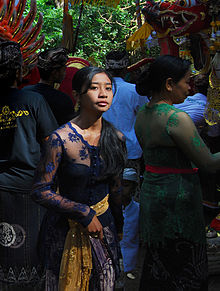Native-Indonesian

|
|
| Total population | |
|---|---|
|
c. 210 million (Worldwide; 2006 estimate) |
|
| Regions with significant populations | |
|
|
|
|
|
21,700,000 |
|
|
850,000 |
|
|
500,000 |
|
|
102,100 |
|
|
101,270 |
|
|
86,196 |
|
|
75,000 |
|
|
10,000 |
| Languages | |
|
Indonesian languages (Indonesian, Javanese, Sundanese, Batak, etc) |
|
| Religion | |
| Islam (predominantly Sunnis, Shias and others), Christianity (Protestantism and Roman Catholicism), Hindu Dharma, Buddhism, Animism, Shamanism, Sunda Wiwitan, Kaharingan, Parmalim, Kejawen, Naurus, Aluk' To Dolo, etc. | |
| Related ethnic groups | |
| Austronesians, Mongoloids, Polynesians, Papuans, Negritos, Melanesians, other Indonesians | |
|
a The figure in Malaysia merely assert those who holds an Indonesian citizenship, the figure doesn't include Malaysian who have some Indonesian ancestry which potentially double or triple of figure, due to the constant migration since millennia ago. |
|
Native Indonesians, or Pribumi/Bumiputra (literally "inlanders"), are members of the population group in Indonesia that shares a similar sociocultural and ethnic heritage whose members are considered natives of the country. The term native Indonesians should not be confused with the more generic term Indonesians or Indonesian citizens.
In ancient Java, the ideas of native versus foreign identities are usually confined into ethno-cultural and language boundaries, as the ideas of Javanese identity being developed. The Kaladi inscription (c. 909 CE), mentioned Kmir (Khmer people of Khmer kingdom) together with Campa (Champa) and Rman (Mon) as foreigners from mainland Southeast Asia that frequently came to Java to trade. The Anjukladang inscription (c. 937 CE) mentioned about infiltration attack from Malayu (which refer to a Srivijayan attack). In this inscription, the ideas of native Javanese is contrasted to its "foreign nemesis", the Malays of Sumatra.
The ethnic composition in the archipelago grew to be more complex with the arrival of the people of foreign origin. Following the adoption of Hinduism, the Southern Indians called by natives as Keling began to arrive in archipelago in the early first millennia, and followed suit by fellow Indians when Tamils began to settles in several ports of Sumatra after the decline of Srivijaya circa 11th century. Also the arrivals of Chinese traders and settlers which intensify since Majapahit era, through the arrival of Zheng He's treasure fleet to Indonesia circa early 15th century. Around the same time, Muslim traders from India and Arabia also began to settle in the region. Caucasian white European arrived when Portuguese began to ruled and settle in Portuguese Malacca in 1511. Thus the ideas of racial identity to describe the differences between the native of the archipelago in contrast to the neighboring Asian foreigners and European white began to take root during early stages of European colonialism in Indonesia circa 16th to 17th century.
...
Wikipedia
